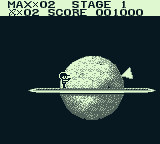The Adventures of Star Saver
The Adventures of Star Saver, known in Japan as Rubble Saver (ラブルセイバー), is a 2D action platformer video game for the Game Boy. It is a quasi-sequel to the earlier Miracle Ropitt for Famicom.
| The Adventures of Star Saver Rubble Saver | |
|---|---|
 North American cover art | |
| Developer(s) | A-Wave[1] |
| Publisher(s) |
|
| Platform(s) | Game Boy |
| Release | |
| Genre(s) | 2D action platformer[1] |
| Mode(s) | Single-player[2] |
Summary

A police officer named Tony and his sister are forced to go inside an unidentified flying object by a group of aliens who are planning to invade the galaxy.[3][4] They are later exiled to a distant planet after refusing to engage in espionage for their side.[3][4]
Tony finds himself stranded on a strange planet where nothing is familiar (and without his sister).[3][4] However, a mech that has a vast knowledge of telepathic skills saves him and empowers Tony with the ability to take on the aliens' army.[3][4] This machine becomes an important ally in the battle to save Tony's sister and stop the extraterrestrial invasion before it's too late.[3][4] The game forces players to fight strange aliens across the galaxy.[3] Various power-ups can be collected to add to the mech's abilities. However, the mech is lost after a single hit.[3] The game includes some surreal enemies like a domestic dog and some musical notes.[5]
In the Japanese version of this game, however, it's Tony's sister you control after you lose the mech,[6] and by extension it's she who has to save Tony.
References
- The Adventures of Star Saver at GameFAQs
- The Adventures of Star Saver at RF Generation
- The Adventures of Star Saver at MobyGames
- The Adventures of Star Saver at Game Boy Database
- The Adventures of Star Saver screenshots at MobyGames
- "Rubble Saver (Star Saver) gameplay, Game Boy" at YouTube